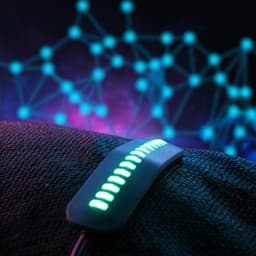Introduction
Ultracold quantum gases, routinely reaching temperatures below a nanokelvin, offer immense potential for quantum sensing and the study of many-body physics. However, their full potential is realized only under conditions of extended free fall, achievable in space. The space environment allows manipulation of quantum gases using undistorted symmetric traps, creating unique configurations like shell topologies or uniform Bose gases. This research uses NASA's Cold Atom Lab (CAL) on the International Space Station (ISS) to create and manipulate Bose-Einstein condensates (BECs), expanding with energies of a few tens of picokelvin. The capabilities demonstrated here, including precise control over position, release velocity, and expansion rate, make CAL a high-precision laboratory for diverse applications such as the study of quantum bubbles, space atom lasers, few-body physics, quantum reflection, entangled state preparation, space-based quantum information processing, quantum simulation, quantum communication, Earth observation, relativistic geodesy, and tests of fundamental physical laws. Overcoming challenges like payload compactness, autonomous operation, and the changing orbital environment are crucial steps in harnessing the potential of space-based quantum gas sources.
Literature Review
Previous research has explored the generation of atomic Bose-Einstein condensates (BECs) in space and in orbit, demonstrating the feasibility of space-based cold atom experiments. However, achieving exquisite control over the quantum state for a wide range of applications remained a challenge. Existing literature highlights the need for fast and robust transport protocols with accurate final positioning, well-controlled release velocities for interferometry, and methods to drastically slow the expansion rate for long observation times. Studies have also investigated various applications of space-based cold atom systems, including quantum simulations, sensing, and communication. This work builds upon this foundation, addressing the limitations of existing techniques and enabling significant advances in quantum state engineering.
Methodology
The experiments were conducted using NASA's Cold Atom Lab (CAL) aboard the ISS. CAL features an atom-chip based system for generating ⁸⁷Rb BECs. To simplify the trapping potential, the BEC was transferred from a five-current evaporation trap to a simplified two-current trap generated by currents through a Z-shaped wire on the atom chip and an external Helmholtz coil pair. Fast atomic transport was achieved using shortcut-to-adiabaticity methods. These methods, benefiting from microgravity, determine a classical trajectory for the atoms, and the trap dynamics are found by inverting Newton's equations. Two transport ramps (A and B) were implemented, with ramp A resulting in a transport distance of 0.42 mm and trap frequencies of (ωx, ωy, ωz) = 2π⋅(25.2, 109, 110) Hz, and ramp B resulting in a transport distance of 0.93 mm and much weaker 3D trapping. The shuttling quality was evaluated by recording in-trap oscillations and varying the time-of-flight. To control the release velocity, the initial hold time was scanned. Finally, delta-kick collimation (DKC) techniques were employed to reduce the expansion energy. The DKC sequence involved releasing the gas, allowing free evolution, and then briefly re-flashing the trapping potential to slow down expansion. Trap A, with its near-cylindrical symmetry, allowed simultaneous collimation along two axes. The experimental results were compared with ab initio models that describe the quantum mean-field dynamics of the condensed gas.
Key Findings
The research achieved significant breakthroughs in three key aspects of quantum state engineering: precise atom shuttling, controlled release velocity, and drastically reduced expansion energy. In the shuttling experiments, residual oscillation amplitudes were reduced to 0.068 ± 0.072 µm for ramp A and 0.40 ± 0.15 µm for ramp B, demonstrating sub-µm positioning accuracy. The controlled release experiments yielded a tunable center-of-mass release velocity with an overall uncertainty of 233 µm s⁻¹, close to state-of-the-art metrological measurements. Delta-kick collimation reduced the expansion energy in the z-direction from 3.6 ± 0.2 nK to 52 ± 10 pK, and the total 3D kinetic energy reached about 100 pK. These results were consistent with theoretical models developed by the researchers. The researchers also verified the stability of the BEC source over several months and millions of kilometers of operation on a 90-minute orbit.
Discussion
The results demonstrate the feasibility of ambitious fundamental physics missions in space, such as the satellite test of the Einstein equivalence principle STE-QUEST. The achieved control over the quantum state of the atomic source surpasses Earth-bound performances in shuttling and positioning precision. The high fidelity and stability of the system over extended periods indicate the maturity of space-borne cold atom laboratories for quantum sensing applications. The precise control over the atomic source's position, velocity, and expansion energy is crucial for enhancing the sensitivity of quantum sensors by leveraging the long free fall times available in space. This work opens avenues for various applications in quantum information processing, satellite gravimetry, matter-wave optics, and space quantum communication.
Conclusion
This study reports state-of-the-art quantum-state engineering of a quantum degenerate gas in the Cold Atom Lab aboard the ISS. The researchers achieved near 70 nm positioning accuracy during rapid transport, controlled release with velocities known to the 100 µm s⁻¹ level, and reduced expansion energy to approximately 50 pK. These results demonstrate the potential of space-based quantum technologies using neutral atoms, satisfying stringent requirements for future space missions in areas such as quantum sensing, communication, and fundamental physics tests. Future improvements, such as increased atom numbers and more flexible current controllers, are expected to further enhance the capabilities of the system.
Limitations
The number of condensed atoms was limited to a maximum of 4000 due to degradation of the alkali metal dispenser. This limitation restricted free evolution times to approximately 400 ms, even for lensed ensembles. Residual magnetic field gradients also affected the atomic motion, although their impact on the dynamics was shown to be negligible. Attempts to transfer atoms to magnetically insensitive states were hindered by the low atom numbers and limited operation time. The experimental setup's limited number of discretization steps in the current control affected the precision of the transport ramps and could have been further improved with more advanced current control systems.
Related Publications
Explore these studies to deepen your understanding of the subject.







